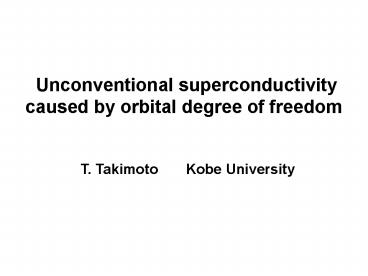Unconventional superconductivity - PowerPoint PPT Presentation
1 / 19
Title:
Unconventional superconductivity
Description:
hole doping. 0. AF. DSC. Spin fluctuation scenario in high-Tc cuprate. yz, zx. xy. 3z2-r2 ... in optimum and over-doped region. FLEX approximation. We apply the ... – PowerPoint PPT presentation
Number of Views:87
Avg rating:3.0/5.0
Title: Unconventional superconductivity
1
Unconventional superconductivity caused by
orbital degree of freedom
T. Takimoto Kobe University
2
Superconductivity in strongly correlated systems
Conventional superconductivity
Unconventional superconductivity
induced by low energy excitation
large on-site Coulomb interaction
in non-degenerate system,
spin fluctuation contributes to the low energy
excitation.
suppression of s-wave pairing
in (quasi-) degenerate system,
in addition to spin fluctuation, orbital
fluctuation and spinorbital fluctuation (coupled
mode) also contribute.
unfavorable situation for conventional
superconductivity
3
Spin fluctuation scenario in high-Tc cuprate
AFSF develops considerably.
x2-y2
3z2-r2
yz, zx
xy
level scheme
CuO2 plane
phase diagram
spin degeneracy
development of spin fluctuation
spin fluctuation induced-superconductivity
(by time reversal invariance)
Thus, we get an interest in effect of orbital
degeneracy to superconductivity.
4
Previous theories for unconventional
superconductivity
As shown above, the theoretical study for
unconventional superconductivity are almost
restricted to the case of non-degenerate system,
because of following difficulties.
1 orbital degeneracy 2 multi Fermi surfaces
We should proceed to systems with orbital degree
of freedom.
5
Our topic
In order to study the superconductivity in
degenerate or quasi-degenerate system, we
develop microscopic theory based on model having
orbital degree of freedom.
We examine effect of orbital degree of freedom to
unconventional superconductivity for following
strongly correlated systems.
Sr2RuO4
I. degenerate case
T. Takimoto, Phys. Rev. B62, R14641(2000).
II. quasi-degenerate case
CeTIn5 (TIr, Co)
T. Takimoto, T. Hotta, and K. Ueda, Phys. Rev.
B69, 104504 (2004).
6
Features of Sr2RuO4
tetragonal system
cylindrical Fermi surfaces
eg
occupying 4 electrons
t2g
level scheme
I. I. Mazin and D. J. Singh, Phys. Rev. Lett.
79, 733 (1997).
Sr2RuO4 shows triplet superconductivity below
1.5K.
Y. Maeno et al., Nature (London) 372, 532 (1994).
In order to study superconducting mechanism of
this system, it is natural to consider two
dimensional model formed by t2g-electrons.
7
Microscopic model
two-dimensional degenerate Hubbard model
featuring Sr2RuO4
U intra-orbital Coulomb U inter-orbital
Coulomb J Hunds coupling J pair hopping
t2g tight-binding bands
e0 orbital energy tx(y) n. n. hopping to
x(y)-direction t n. n. n. hopping
8
Effective interaction Hamiltonian
within RPA, following effective interaction
Hamiltonian is obtained near spin and orbital
instabilities.
spin part of effective interaction
scattering effect by SF
charge part of effective interaction
scattering effect by OF
9
Spin and orbital fluctuations
spin fluctuations of dyz develops at qA by
increase of intra-orbital Coulomb interaction U
orbital fluctuation between dyz and dzx develops
at qA and qB by increase of inter-orbital
Coulomb interaction U
10
Superconducting transition
phase diagram
superconducting gap equation within weak
coupling theory
hs
ht
singlet
triplet
From this figure, when system is close to both
instabilities of spin and orbital, triplet
superconductivity appears with the cooperative
relation between spin and orbital fluctuations.
11
Result of first part
In orbital degenerate system, triplet
superconductivity appears when both spin and
orbital fluctuations develop.
12
Features of CeTIn5
CeTIn5
CeRhIn5 AF TN3.8K CeIrIn5 SC
Tc0.4K CeCoIn5 SC Tc2.3K
H. Hegger et al. Phys. Rev. Lett. 84 4986,
(2000).
C. Petrovic et al. Europhys. Lett. 53 354,
(2001).
C. Petrovic et al. J. Phys. Condens. Matter 13
L337, (2001).
crystal structure
phase diagram of CeRh1-xIrxIn5
P. G. Pagliuso et al. Phys. Rev. B64 R100503,
(2001).
The superconducting phase appears in the
neighborhood of the AF phase in CeRh1-xIrxIn5
systems.
Reflecting the tetragonal crystal structure,
cylindrical Fermi surfaces are observed which
are consistent with the band calculation.
13
Minimal Model
local level structure
quasi-degeneracy
small energy scale
hopping process
Considering a square lattice composed by Ce3-ion
creation operator of f-electron
t1 G7 t2 G6
D orbital splitting energy
In the following, we restrict ourselves to the
realistic case UU.
We estimate nearest-neighbor hopping for
f-electron, with taking into account
anisotropies of wave functions for G6 and G7
14
FLEX approximation
Spin and orbital fluctuations
We apply the fluctuation exchange
(FLEX) approximation to the orbital degenerate
model mentioned above.
D0
D0
properties of FLEX approximation
1) compared with RPA, mode-coupling effect is
incorporated 2) the spin and orbital fluctuations
and spectra of f-electrons are
self-consistently determined 3) when applied to
the high-Tc cuprate, it is successful to
understand the normal and superconducting
states consistently in optimum and over-doped
region
D2
D2
For D0, AF spin fluctuation of G7-orbital is
enhanced, but not sufficiently developed to
induce superconductivity
For D2, the AF spin fluctuation of G7-orbital
considerably develops, and any orbital
fluctuation is suppressed
15
Phase diagram
1) The spin-singlet superconducting phase
with B1g-symmetry appears next to the AF
phase.
2) The superconducting transition
temperature is suppressed with decreasing D.
This superconducting phase is induced by the
development of the antiferromagnetic spin
fluctuation in G7-orbital with increasing the
orbital splitting energy D.
16
Result of second part
The orbital splitting energy is the parameter
controlling the change from antiferromagnetic
to the dx2-y2-wave superconducting phase in
quarter filling two-orbital system.
17
Summary
1. In orbital degenerate system, the triplet
superconducting phase appears when both spin
and orbital fluctuations develop.
2. In quasi-degenerate system, the orbital
splitting energy is the parameter
controlling the dx2-y2-wave superconducting
transition temperature.
From these results, it is shown that the orbital
degree of freedom plays some important roles for
unconventional superconductivity in strongly
correlated systems.
18
charge fluctuation in strongly correlated systems
large on-site Coulomb interaction
suppression of charge fluctuation
Thus, charge fluctuation should not contribute to
low-energy excitation.
In the following, we leave charge fluctuation out
of consideration.
19
Fermi surfaces and static susceptibilities
Fermi surfaces
static susceptibilities































